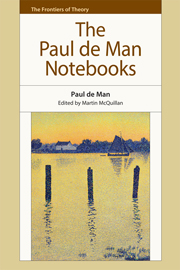Book contents
- Frontmatter
- Contents
- Series Editor's Preface
- Acknowledgements
- Dedication
- Introduction: ‘The Unimaginable Touch of Time’: The Public and Private in the Notebooks of Paul de Man
- PART I Texts
- 1 The Drawings of Paul Valéry (1948)
- 2 Jacques Villon (1952)
- 3 Graduate Essay on Keats (1954)
- 4 Postdoctoral Essay on Symbolism (c. 1960)
- 5 Introduction to Madame Bovary (1965)
- 6 Introduction to The Portable Rousseau (1973)
- 7 On Reading Rousseau (1977)
- 8 Translator's Introduction to “Rousseau and English Romanticism” (1978)
- 9 Rousseau and English Romanticism (1978)
- 10 Introduction to Studies in Romanticism (1979)
- 11 Hommage à Georges Poulet (1982)
- 12 A Letter from Paul de Man (1982)
- 13 Reply to Raymond Geuss (1983)
- 14 Interview with Robert Moynihan (1984)
- PART II Translations
- PART III Teaching
- PART IV Research
- Appendix. The Notebooks of Paul de Man 1963–83
- Bibliography
- Index of Names
2 - Jacques Villon (1952)
from PART I - Texts
Published online by Cambridge University Press: 05 December 2014
- Frontmatter
- Contents
- Series Editor's Preface
- Acknowledgements
- Dedication
- Introduction: ‘The Unimaginable Touch of Time’: The Public and Private in the Notebooks of Paul de Man
- PART I Texts
- 1 The Drawings of Paul Valéry (1948)
- 2 Jacques Villon (1952)
- 3 Graduate Essay on Keats (1954)
- 4 Postdoctoral Essay on Symbolism (c. 1960)
- 5 Introduction to Madame Bovary (1965)
- 6 Introduction to The Portable Rousseau (1973)
- 7 On Reading Rousseau (1977)
- 8 Translator's Introduction to “Rousseau and English Romanticism” (1978)
- 9 Rousseau and English Romanticism (1978)
- 10 Introduction to Studies in Romanticism (1979)
- 11 Hommage à Georges Poulet (1982)
- 12 A Letter from Paul de Man (1982)
- 13 Reply to Raymond Geuss (1983)
- 14 Interview with Robert Moynihan (1984)
- PART II Translations
- PART III Teaching
- PART IV Research
- Appendix. The Notebooks of Paul de Man 1963–83
- Bibliography
- Index of Names
Summary
One brilliant sunny afternoon last spring I stepped through the gate which leads deep into the small garden where Jacques Villon's studio is housed. It is one of these suburbs which despite their nearness to Paris appear with their bird's nests, enclosures, and vegetable patches as if they were in the countryside, and the worn-out plastered houses give one the impression of a rustic village. Cut ivy filled the alleyway. There must have been a debate between the head gardener and the artist over how best to bind down the crazy grapevine that stretched itself over the wall's edge.
Inside the studio an unfinished canvas displayed the same harsh freshness, the same asperity that one could sense outside, with the spring tallying its first signs of green with the dirty grey and brown of the still wintry ground. “Painting is my second existence” says Villon with an introvert smile that creases his face. “My first one was graphics. As a matter of fact, one should have four existences.” – “So what will be the third one?” I inquire. “I believe it should be graphics again – don't know about the fourth.” He made a wavering motion as if he found it very difficult to make that choice with all the thirst for knowledge that still remained for him to satisfy. While speaking, [he was looking for] his recently finished samples of a few illustrations based on Paul Valery's translations of Virgil's Eclogues. He had just received the drafts and wanted to show them to me. He spread out the pictures in their different stages, copies, series of sketches whose pastoral landscapes swarmed with flocks of sheep, gods, shepherds, and carnations. First there was Rostrum rising from amidst the Roman public like the stem of a trireme galley at anchor, and at last I caught glimpses of Galatea, who, with her tied-up tunic, fled among the trees.
- Type
- Chapter
- Information
- The Paul de Man Notebooks , pp. 38 - 41Publisher: Edinburgh University PressPrint publication year: 2014

